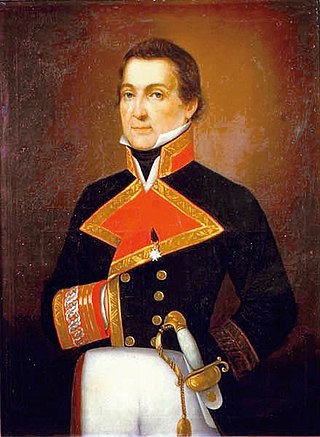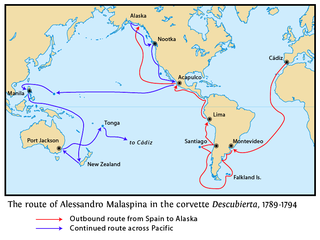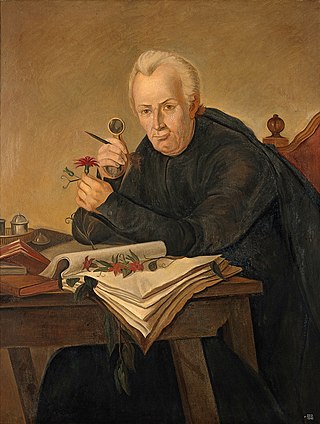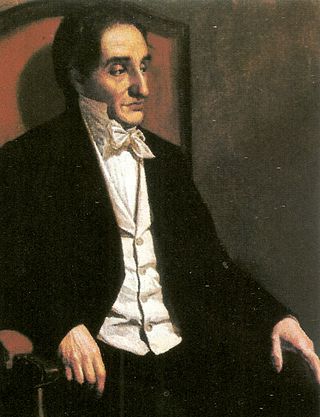
Charles IV was King of Spain and ruler of the Spanish Empire from 1788 to 1808.

Alejandro Malaspina was a Tuscan explorer who spent most of his life as a Spanish naval officer. Under a Spanish royal commission, he undertook a voyage around the world from 1786 to 1788, then, from 1789 to 1794, a scientific expedition throughout the Pacific Ocean, exploring and mapping much of the west coast of the Americas from Cape Horn to the Gulf of Alaska, crossing to Guam and the Philippines, and stopping in New Zealand, Australia, and Tonga.

Antonio José Cavanilles was a leading Spanish taxonomic botanist, artist and one of the most important figures in the 18th century period of Enlightenment in Spain.

Andrés de Urdaneta was a maritime explorer for the Spanish Empire of Basque heritage, who became an Augustinian friar. At the age of seventeen, he formed part of the Loaísa expedition to the Spice Islands where he spent more than eight years. Around 1540 he settled in New Spain and became an Augustinian friar in 1552. At the request of Philip II he joined the Legazpi expedition for a return to the Philippines. In 1565, Urdaneta discovered and plotted an easterly route across the Pacific Ocean, from the Philippines to Acapulco in the Viceroyalty of New Spain. The route made it practical for Spain to colonize the Philippines and was used as the Manila galleon trade route for more than two hundred years.
The ideas of the Age of Enlightenment came to Spain in the 18th century with the new Bourbon dynasty, following the death of the last Habsburg monarch, Charles II, in 1700. The period of reform and 'enlightened despotism' under the eighteenth-century Bourbons focused on centralizing and modernizing the Spanish government, and improvement of infrastructure, beginning with the rule of King Charles III and the work of his minister, José Moñino, count of Floridablanca. In the political and economic sphere, the crown implemented a series of changes, collectively known as the Bourbon reforms, which were aimed at making the overseas empire more prosperous to the benefit of Spain.

Georg Heinrich Freiherr von Langsdorff was a German naturalist and explorer, as well as a Russian diplomat, better known by his Russian name, Grigori Ivanovich Langsdorf.
Martín Sessé y Lacasta was a Spanish botanist, who relocated to New Spain during the 18th century to study and classify the flora of the territory. The standard author abbreviation Sessé is used to indicate this person as the author when citing a botanical name.

The Malaspina Expedition (1789–1794) was a five-year maritime scientific exploration commanded by Alejandro Malaspina and José de Bustamante y Guerra. Although the expedition receives its name from Malaspina, he always insisted on giving Bustamante an equal share of command. Bustamante had, however, acknowledged Malaspina as the "head of the expedition" since the beginning.

José Celestino Bruno Mutis y Bosio was a Spanish priest, botanist and mathematician. He was a significant figure in the Spanish American Enlightenment, whom Alexander von Humboldt met with on his expedition to Spanish America. He is one of the most important authors of the Spanish Universalist School of the 18th century, together with Juan Andrés or Antonio Eximeno.

Hipólito Ruiz López, or Hipólito Ruiz, was a Spanish botanist known for researching the floras of Peru and Chile during an expedition under Carlos III from 1777 to 1788. During the reign of Carlos III, three major botanical expeditions were sent to the New World; Ruiz and José Antonio Pavón Jiménez were the botanists for the first of these expeditions, to Peru and Chile.

Antonio José Amar y Borbón Arguedas was a Spanish military officer and colonial official. From September 16, 1803 to July 20, 1810 he was viceroy of Viceroyalty of New Granada. During his mandate he faced the beginning of the independence movement. He is also remembered for introducing costumes and masked balls in the society of Bogotá.
Father Marià Paieres i Borràs (Catalan), commonly known as Mariano Payeras Borrás or Padre Mariano Payeras was a Spanish missionary to the Americas.
The Free Company of Volunteers of Catalonia was a military company of the Spanish Army serving in the Spanish colonial empire.
José Mariano Mociño Suárez Lozano, or simply José Mariano Mociño, was a naturalist from Mexico.

Atanasio Echeverría y Godoy was an 18th-century botanical artist and naturalist from New Spain who trained at the Royal Art Academy in Mexico City. The genus Echeveria was named in his honour by Augustin Pyramus de Candolle.

The Duke of Gloucester Islands is a subgroup of the Tuamotu group in French Polynesia. They are located southeast of Tahiti and south of the main Tuamotu atoll cluster and are rather isolated.

Nukutepipi, or Nuku-te-pipi is an atoll in French Polynesia, Pacific Ocean. It is part of the Duke of Gloucester Islands, a subgroup of the Tuamotu group. Nukutepipi's nearest neighbor is Anuanurunga, which is located about 22 km to the WNW.

Juan Francisco Antonio Hilarión Zea Díaz was a Neogranadine journalist, botanist, diplomat, politician, and statesman who served as Vice President of Colombia under then President Simón Bolívar. He was also Ambassador of Colombia to the United Kingdom where he tried in vain to gain recognition for the nascent nation of Colombia.
The Royal Botanical Expedition to New Spain was a scientific expedition to survey the flora and fauna of the territories of New Spain between 1787 and 1803 and to establish a botanical garden. It was sponsored by King Charles III of Spain and headed by physician Martín Sessé y Lacasta, who led a team of botanists that included José Mariano Mociño and is part of the crown's general program of economic revitalization, known as the Bourbon Reforms. The expedition, commonly referred to by botanists as the Sessé and Mociño expedition, identified many species new to science and brought back a large trove of valuable botanical illustrations. The expedition was "an undertaking that was to signal Spain's reassertion of its colonial might and of its relevance to the Enlightenment."
The Botanical Expedition to the Viceroyalty of Peru was a Spanish expedition to the colonial territories of the Viceroyalty of Peru and Chile between 1777 and 1788.












